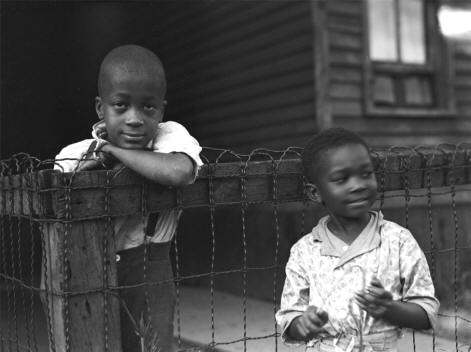| |

An image
from the
Walter
P.
Reuther
Library's
new
Edward
Stanton
Photographs,
featuring
children
in the
historic
black
neighborhoods
of
Detroit's
near
east
side.
The
library
is
seeking
help
identifying
the
people
in the
photographs,
which
are
estimated
to have
been
taken in
the late
1930's
or early
1940's. |
| |
WSU
Walter
P.
Reuther
Library:
Help is
needed
to
identify
rare
photos
By Ken
Coleman
/Tell Us
Detroit
DETROIT
-
History
lives
and a
new
collection
acquired
by Wayne
State
University’s
Walter
P.
Reuther
Library
reveals
a set of
photos
that are
as
vibrant
as they
are
vivid.
The
black
life in
Detroit
during
what
appears
to be
the
1930s
and ‘40s
illustrate
scenes
of
children
on what
looks to
be
city’s
lower
east
side,
perhaps
Black
Bottom.
The
library
recently
acquired
Edward
Stanton
Photographs
collection.
The
names,
location
and year
the 96
photos
were
taken is
missing
and the
library
wants
the
public’s
assistance
in
helping
to
provide
those
answers.
Stanton,
a white
man and
Detroit
native,
was
fascinated
with
photography
and had
a
“Bohemian”
or
unconventional
spirit,
according
to
author
and
university
journalism
professor
Tom
Stanton,
his
nephew.
Tom was
interviewed
recently
by
MLive.com.
“When we
received
these
photos
from the
donor,
we
couldn’t
stop
thinking
about
the fact
that
these
were
neighborhoods
where
real
people
lived
and led
full and
interesting
lives,”
said
Elizabeth
Clemens,
audiovisual
archivist
at the
Reuther
Library.
“We’d
love to
put a
name to
these
faces so
that we
can
document
those
stories
that
haven’t
been
told.”
Although
blacks
have
been
residents
of
Detroit
since
the 19th
century
and
built
institutions
like
Second
Baptist
Church
in 1836,
the
population
of the
community
skyrocketed
from
5,700
people
in 1900
to
120,000
in 1930.
Most of
them
settled
on the
city’s
lower
east
side in
the
Brush
Park,
Paradise
Valley
and
Black
Bottom
neighborhoods
along
streets
like St.
Aubin,
Hastings,
St.
Antoine,
Beaubien,
Brush,
and John
R.
By 1920,
more
than 350
businesses
were
owned
and
operated
by
African
Americans,
including
doctor
and
dentist’s
offices;
homes of
worship;
funeral
homes;
small
grocery
stores;
fraternities
and
sororities;
masonic
lodges,
as well
as
social
service
and
social
justice
institutions
like the
Urban
League
and
NAACP.
The
community’s
first
black
local
elected
official
was Dr.
Samuel
Watson,
a member
of the
City
Council
in 1882.
Its
first
black
member
of the
state
legislature
was
William
Ferguson,
a
Democratic
and
member
of the
Michigan
House of
Representatives.
He was
elected
in 1892.
Race
discrimination
in
mortgage
lending
and
hostile
attitudes
by
whites,
however,
effectively
prevented
blacks
from
living
in other
parts of
the
city.
But
small
black
enclaves
on the
city’s
west
side,
north
east
side in
Conant
Gardens,
and in
the
Eight
Mile
Road-Wyoming
Street
area
surfaced
by the
1920s.
Several
of the
Stanton
photos
are on
display
in the
lobby of
the
library,
which is
located
on Wayne
State
University’s
main
campus
on Cass
Avenue
near
Kirby
Street.
A large
selection
of
images
has been
digitized
and is
available
to view
in the
Edward
Stanton
Image
Gallery
on the
Reuther
Library’s
Web
site:
www.reuther.wayne.edu/image/tid/1983.
For more
information
on the
Edward
Stanton
Photographs
contact
an
audiovisual
archivist
at
www.reutherav@wayne.edu
or
university
publicist
Jill
Wurm
(313)
577-4149;
Email:
ae0831@wayne.edu
Ken
Coleman,
a
Detroit-based
author
and
historian,
chronicles
black
life in
Detroit.
He can
be
reached
at
www.historylivesDetroit.com
|
| |

|
|
|
|
|